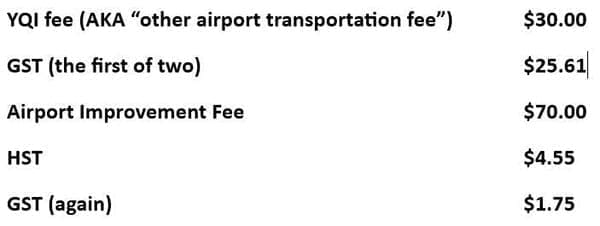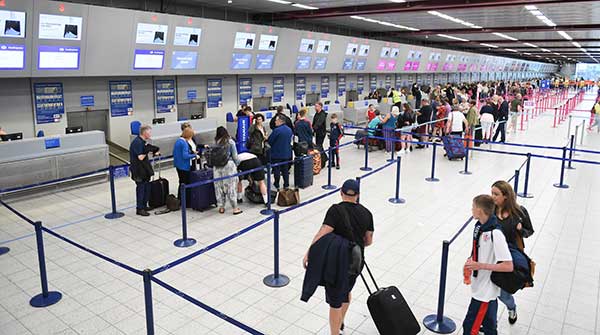Why Canadian airfares are among the highest in the developed world and how the government games the system
 The holiday season, for all its positives, is also a painful reminder of how much Canadians have learned to loathe our airlines, especially when we are held hostage to high fares.
The holiday season, for all its positives, is also a painful reminder of how much Canadians have learned to loathe our airlines, especially when we are held hostage to high fares.
Not only do families have to battle the chaos at choked airports, but they must also contend with grumpy flight attendants, overweight bag fees, and – yes, even today – the risk that a checked bag may not show up at your destination. And all this while you’re paying a premium price because everyone wants to travel at the same time.
It has been proven time and again that Canadian airfares are among the highest in the developed world. We look longingly to the United States, Europe, Southeast Asia, and many other parts of the world, where airlines offer fares that seem too cheap to believe. How can they do it and yet our airlines cannot?
I am not prepared to absolve Air Canada and WestJet entirely for their semi-monopolistic pricing practices. But there is another powerful reason why Canadians will pay excessively high prices to fly for the foreseeable future.
It’s our money-grubbing, cash-addicted, duplicitous federal government.
The government has woven an onerous cat’s cradle of taxes and fees that make it impossible for domestic airlines to offer rates that could compete with what we see in other countries. And bureaucrats, those clever Machiavellians, have created an opaque series of card tricks that make it appear that high prices are the airlines’ fault.
But, if consumers review their statements, the evidence is all there. A recent flight I booked from Calgary to Toronto illustrates the point. (In this case, the fare is low because I used some banked credits.)
WestJet charged $474 for the flight but then added in six mandated fees equalling $146.76, or roughly 25 percent of the total fare.

But those taxes and fees aren’t the whole story. The Montreal Economic Institute (MEI) recently released a report that details the three cost areas that have a direct impact on Canadian airfares: airport rents, security fees, and the fuel tax.
It should come as a shock to no one that the feds have been using our airports as a cash cow. As the chart shows, airports paid the feds a total of $419 million in rents for the 2022-2023 fiscal year – 42.5 percent more than it did just 10 years ago. (There was a one-year blip while rents were suspended during COVID.)

Did the feds invest that money back into airport infrastructure? No way! MEI reports that in the years 2013-2020, the feds’ Airports Capital Assistance Program coughed up an average of just $32 million per year – about nine percent of what it collected.
This, in turn, has forced airports to impose airport improvement fees, which are charged directly to passengers on their plane tickets. Those fees are now $35 at Toronto’s Pearson, Canada’s busiest airport. As the MEI report notes, “The rents imposed on the airport authorities in order to increase government revenues … act as [yet another] tax imposed on travellers.”
The airport security fee, imposed after the 9/11 attacks, is another irritant. You know that 30 seconds (on a good day) it takes to clear security? That costs you $7.48 for a one-way domestic flight and $25.91 for an international flight. With a 33 percent fee hike planned for May 2024, the feds will rake in another $1.2 billion in revenue over the coming four fiscal years.
The security fee in the U.S., by the way, is a maximum of $15.30 CAD.
Fuel taxes pile on the costs. Canadians pay a tax of four cents per litre of aviation fuel, while the U.S. charges its airlines the equivalent of 1.55 cents CAD per litre.
Charges upon charges, taxes upon taxes – it appears to be the Canadian way.
Airport terminals are to airplanes what highways are to cars – essential infrastructure. Having to pay a series of fees every time we use an airport is like having to pay a toll every time we drive on a road. If governments tried to do such a thing, there would be open rebellion.
Now, some readers may jump on this issue to blame Justin Trudeau. In fact, it was a much earlier Liberal government that put us on this disastrous path.
Fees at airports took off in the 1990s when the Liberal government of the day created the National Airports Policy. Doug Young, the Transport minister who oversaw the creation of the policy, was later quoted as saying it was the worst decision of his career and that he regretted its implementation. The Canadian Owners and Pilots Association declared in its 2020 Guide to Public Airports, “It is clear that the National Airports Policy has been a failure for many airports.”
There is a potential path out of this morass. The federal government could eliminate airport rental payments and yet satiate its need for cash by selling all or part of airports to private firms. A 2017 study by the C.D. Howe Institute argued that the federal rent structure that Ottawa charges airports creates a strong disincentive for airports to seek new revenues. It also found that for-profit airports are more efficient and passenger-friendly, and that airport charges fell in Europe when governments opened up ownership of their airports.
Perhaps, in the era of fossil-fuel-driven climate change, we should all travel less. But people of the world are more mobile than they have ever been in human history. Like many of you, I have family scattered from one end of the country to the other. I’m not prepared to give up on ever seeing them in person again.
We do need technologies that will enable us to fly with vastly reduced carbon emissions. But first, we need airfares that are more in line with the rest of the world.
Doug Firby is an award-winning editorial writer with over four decades of experience working for newspapers, magazines and online publications in Ontario and western Canada. Previously, he served as Editorial Page Editor at the Calgary Herald.
For interview requests, click here.
The opinions expressed by our columnists and contributors are theirs alone and do not inherently or expressly reflect the views of our publication.
© Troy Media
Troy Media is an editorial content provider to media outlets and its own hosted community news outlets across Canada.

